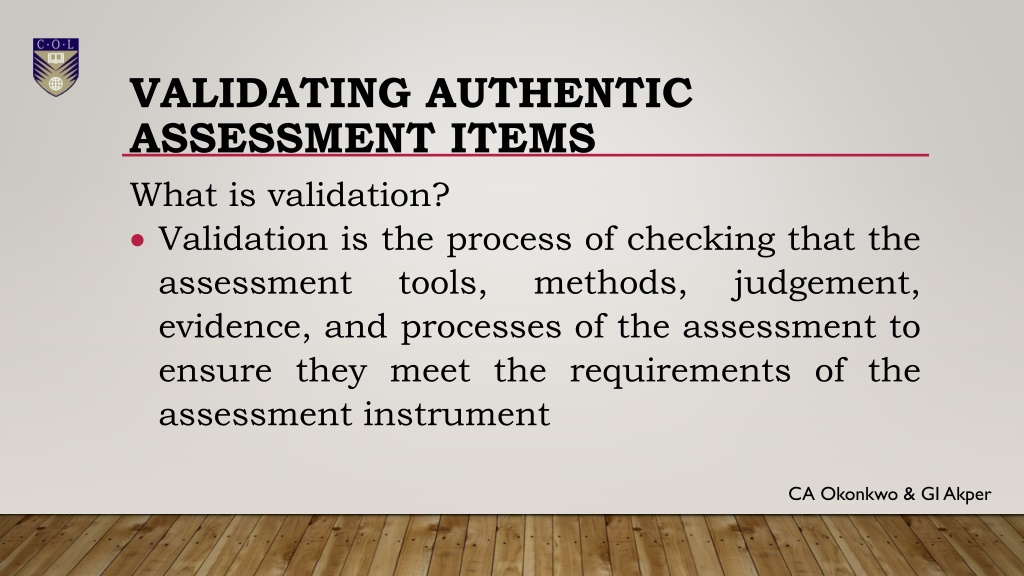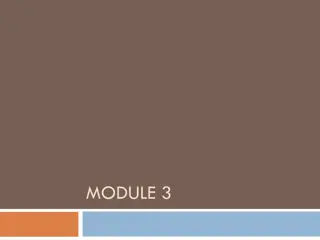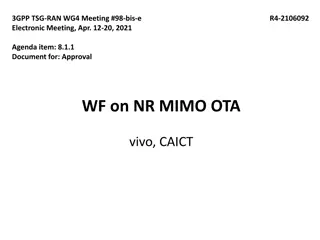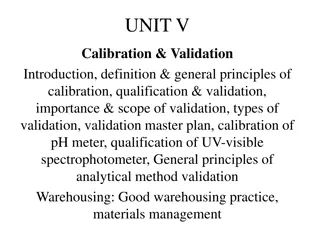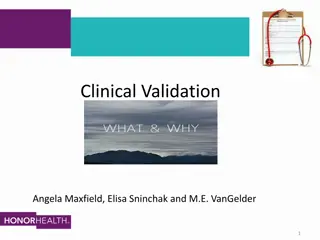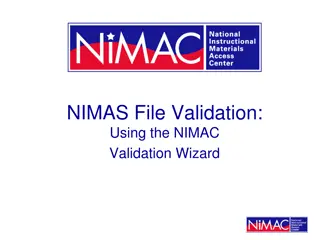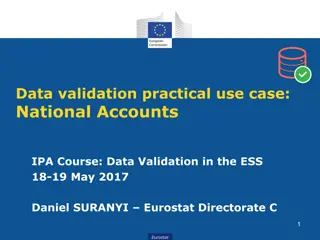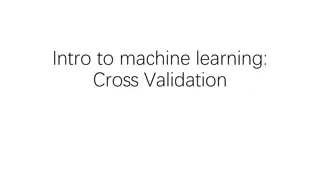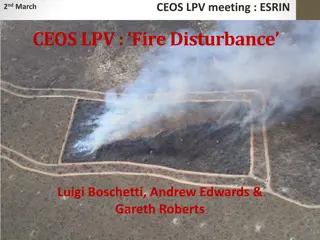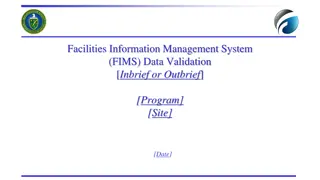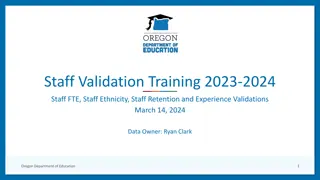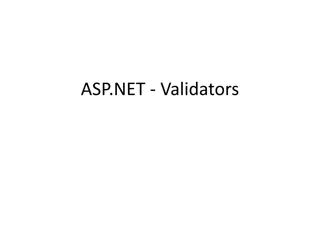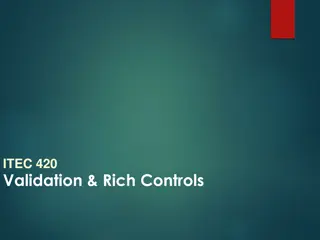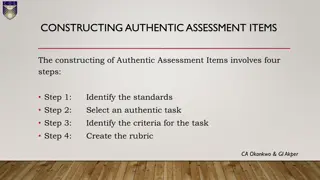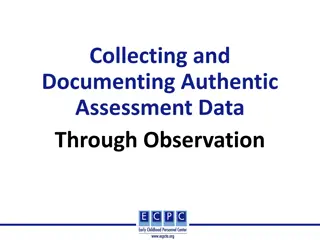Understanding Validation in Authentic Assessment Items
Validation in authentic assessment items is crucial for ensuring the quality and effectiveness of assessment tools. It involves a thorough review process to confirm that the test items are valid, reliable, and produce authentic evidence for making sound judgments. Various aspects of validation, including the validation process, types of validity, and construct validity, are essential in assuring the appropriateness and accuracy of assessment items.
Download Presentation

Please find below an Image/Link to download the presentation.
The content on the website is provided AS IS for your information and personal use only. It may not be sold, licensed, or shared on other websites without obtaining consent from the author. Download presentation by click this link. If you encounter any issues during the download, it is possible that the publisher has removed the file from their server.
E N D
Presentation Transcript
VALIDATING AUTHENTIC ASSESSMENT ITEMS What is validation? Validation is the process of checking that the assessment tools, evidence, and processes of the assessment to ensure they meet the requirements of the assessment instrument methods, judgement, CA Okonkwo & GI Akper
THE CONCEPT OF VALIDATION (I) Validation is the quality review process of the authentic assessment items. It involves confirming that the test items are good enough to produce valid, reliable, sufficient, current, and authentic evidence when administered to enable reasonable judgements to be made based on the result of the items administration results. CA Okonkwo & GI Akper
THE CONCEPT OF VALIDATION (II) It includes: Reviewing items that do not pass the standard and criteria set for the test items Make recommendations improvements to the test items Acting upon such recommendations for the future CA Okonkwo & GI Akper
THE CONCEPT OF VALIDATION (III) Validity of Authentic Assessment Items means appropriateness of the authentic assessment items Ensuring that AA items are valid for the desired outcome It is a qualitative review process to confirm that the questions relating to the construction of authentic assessment tasks are effectively and appropriately taken care of in the assessment task CA Okonkwo & GI Akper
TYPES OF VALIDITY Different types of validity are examined before an AA item is accepted as valid Validity tells us how accurately an item measures what it claims to measure If an item measures what it claims to measure, and the results closely corresponds to real-world values, then it can be considered valid Validation may refer to: the items interpretations assessment; and/or the application of the test results to educational decisions of scores derived from the CA Okonkwo & GI Akper
CONSTRUCT VALIDITY (I) Refers to whether the method of assessment will actually elicit the desired response from the examinees Does the item measure the concepts that it intended to measure? Construct represents the interest we are interested in measuring with that item or items validity evaluates whether an item really A construct refers to a concept or characteristics that cannot be directly observed but can be measured by observing other indicators that are assessed with it CA Okonkwo & GI Akper
CONSTRUCT VALIDITY II Construct can be characteristic of individuals such as intelligence, obesity, job satisfaction or depression among others They can also be broader organizations or social groups such as gender equality, corporate social responsibilities, or freedom of speech concepts applied to CA Okonkwo & GI Akper
CONSTRUCT VALIDITY III Some of these concepts can only be measured by indicators Hence, construct validity is about ensuring that the items of measurement match the construct we intend to measure CA Okonkwo & GI Akper
CONTENT VALIDITY (I) Content validity assesses whether authentic assessment items are representative of all aspects of the construct To produce valid results, the content of the authentic assessment items must cover all relevant parts of the subject it aims to measure If some aspects are missing from the measurement (or irrelevant aspects are included), the validity is threatened CA Okonkwo & GI Akper
CONTENT VALIDITY (II) Content validity is usually determined by the experts in the content area to be assessed. Content validity requires the use of recognized subject matter experts to evaluate whether the items designed for the assessment are relevant for defined content Content validity requires more rigorous statistical test than does the assessment of face validity CA Okonkwo & GI Akper
CONTENT VALIDITY (III) Content validity in academic and vocational areas authentic assessment items need to reflect the knowledge actually required for a given topic area or job skills Succinctly put, an item has content validity if it measures knowledge of the content domain of which it was designed to measure its knowledge That is, content validity concerns primarily the adequacy with which the authentic assessment items adequately and representatively sample the content areas to be measured CA Okonkwo & GI Akper
CONTENT VALIDITY (IV) What provides evidence of content validity? Test blueprint and specifications serve as foundation of validity evidence for determining the extent to which the test provides sufficient content coverage CA Okonkwo & GI Akper
HOW IS CONTENT VALIDITY ESTABLISHED? In documenting that the structure and content (items) capture the connection between: practical terms, content validity is determined by the intended measurement concepts and the way learners from the target student discuss that concept, or population understand and the targeted important work behaviors, activities, worker requirements or outcomes of the learning content in real world. CA Okonkwo & GI Akper
FACE VALIDITY (I) Face validity considers how suitable the content of an item or authentic assessment items seems to be on the surface Face validity assesses whether the items looks valid to stakeholders. It is similar to content validity, but face validity is a more informal and subjective assessment CA Okonkwo & GI Akper
FACE VALIDITY (II) It is a subjective measure and its often considered the weakest form of validity However, it can be useful in the initial stages of developing the items where it could be employed to determine whether the authentic assessment items appear to measure what it is supposed to measure CA Okonkwo & GI Akper
CRITERION VALIDITY Criterion validity evaluates how well authentic assessment items can predict a concrete outcome, or how well the results of the authentic assessment items (would) approximate the results of another set of authentic assessment items already validated. A criterion variable is an established measurement that is widely considered valid, sometimes measurement. inferred to gold standard Criterion variables can be very difficult to find. Criterion validity of an instrument is judged based on the criteria set for the assessment. CA Okonkwo & GI Akper
HOW IS CRITERION VALIDITY ESTABLISHED? To evaluate authentic assessment items for criterion validity, the result of the administered authentic items is correlated with the result of earlier established authentic assessment criterion measurement. A high correlation gives a good indication that the authentic assessment item is measuring what it intends to measure CA Okonkwo & GI Akper
HOW IS CRITERION VALIDITY ESTABLISHED? To establish the criterion validity of the new authentic assessment items, both the new items and the earlier ones (known valid measure administered to the same cohort of learners. of the criterion) are The results of both sets of items administered on the same group of learners are correlated and compared. If the outcomes are very similar, the new set of authentic assessment items are said to have high criterion validity CA Okonkwo & GI Akper
CONCURRENT VALIDITY & PREDICTIVE VALIDITY Concurrent validity Concurrent validity refers to how the authentic assessment items compare with similar instruments that measure the same criterion. Predictive validity Predictive validity is concerned with how well an individual s authentic assessment item measures how successful he will be on the same future measure. performance on an CA Okonkwo & GI Akper
VALIDATION - THE QUALITY REVIEW PROCESS (I) Checking whether the items are in conformity with: the learning outcomes, the standard, the criteria, the professional, and accreditation body requirements, earlier set out to achieve with the authentic assessment items constructed to be able to produce valid, reliable, sufficient, current, and authentic evidence to enable reasonable judgments to be made as to whether the requirements of the authentic assessment items are met. CA Okonkwo & GI Akper
VALIDATION - THE QUALITY REVIEW PROCESS (II) For the authentic assessment items to be valid, the items require: oTo cover the broad knowledge that are essential for competent performance of the unit or theme performance. range of skills and CA Okonkwo & GI Akper
VALIDATION - THE QUALITY REVIEW PROCESS (III) oThe knowledge and skills required by the unit or theme are integrated with their practical application. oThe authentic assessment items are to be based on evidence that demonstrate that the learner could demonstrate these skills and knowledge in other similar situations. CA Okonkwo & GI Akper
VALIDATION - THE QUALITY REVIEW PROCESS III oThe judgment of competency is based on evidence supplied by the learner against the unit or theme requirements. For the authentic assessment items to be valid, the assessor is to assure that the items are such that the learner has the skill, knowledge and attributes as described in the unit or theme competencies requirements. CA Okonkwo & GI Akper
HANDS ON 2 TO VALIDATE THE CONSTRUCTED AUTHENTIC ASSESSMENT ITEMS To validate the authentic assessment items constructed we have to consider the infographic (Mueller, 2018) that guided the authentic assessment item construction process and provide answers to the questions posed. That is, we should provide answers to the questions with respect to the specific authentic assessment items constructed in this sensitization workshop. CA Okonkwo & GI Akper
HANDS ON 2 TO VALIDATE THE CONSTRUCTED AUTHENTIC ASSESSMENT ITEMS I CA Okonkwo & GI Akper
TO VALIDATE THE CONSTRUCTED AUTHENTIC ASSESSMENT ITEMS II CA Okonkwo & GI Akper
RUBRIC FOR VALIDATING THE CONSTRUCTED AUTHENTIC ASSESSMENT ITEMS Group: Subject area: Item No.: Criteria Step 1: Identify the Standards Step 2: Select an Authentic Task Step 3: Identify the Criteria for the Task Step 4: Create the Rubric The Authentic Assessment Item 1 Weight 4points 3points 2points 1point Comment CA Okonkwo & GI Akper
RECAP Repeat the same process for the items you have constructed and present to the participants for critique Self and Peer Assessment and Validation. Identify areas that need improvement and suggest ways of improving such areas. Submit softcopy to the facilitators for their input. CA Okonkwo & GI Akper
APPRECIATION WE THANK YOU IMMENSELY FOR YOUR VERY ACTIVE PARTICIPATION
